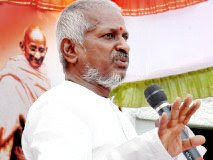1st song's lyric was penned by Gangai amaran that was sung by TMS. The song was about Lord Shiva. Unfortunately, that project was called-off.
Later, a couple of similar movies were dropped off, for which Raaja sir was signed to take care of music department.
An Annakili started flying over the musical sky:
Exactly, the same date before 35 years, the movie - Annakili was released {14th May 1976}. Through which our Raaja sir was incarnated as an individual composer. Raaja sir not only got his métier by this movie, however, He has dedicated Himself & His life for music and became inspiration & almost as a demi-god for many music aspirants.
This movie has six songs as below:
1. Adi raakaayi mookkaayi - Suththa chamba pachcha nellu - S.Janaki & Chorus
2. Annakkili unnai theduthe - S.Janaki
3. Annakkili unnai theduthu - T.M.Soundararajan
4. Machchanap paaththeengalaa - S.Janaki
5. Sonthamillai panthamillai - P.Susheela
6. Machchanap paaththeengalaa – Pathos
And some coincidences are,
1) His first Oratoria {Thiruvasagam} also has 6 songs.
2) 14 - 05 – 1976…1+4 = 5, 05, 1+9+7+6 = 5.
His first symphony has 5 movements.
He has invented the ragam 'Pancha'mukhi.
His 500th movie was 'Anja'li...lol
3) His first cine song - Annakili unna theduthae and first song in Oratoria - Poovar Senni Mannan are based on the ragam - Sindhu Bhairavi & ¾ time signature.
While talking about its compositions, there is always a fuss that Raaja sir is the first composer who has introduced folk music in tamil cine music. Of course, not...However, He has musically fabricated the folk tunes with Carnatic and western idioms, which is an innovate factor, like usage of harmony {western idiom} in Machchanap paaththeengalaa or arpeggios in a lude of Annakili Unna theduthae & when Sivakumar reveals about his necessity of job & in other scene, Sivakumar talks about his marriage to Annam, arpeggios were played in ¾ timing. Classical guitar played vital role in the songs & re-recording & also, usage of Moog synthesizer/synthesizer in Adi raakaayi mookkaayi - suththa chamba pachcha nellu and many to be pointed out.
It was actually ace-musician Chandrasekar’s synthesizer was played in this movie, however, due to his absence; some other musician has played the synthesizer.
Title card begins with ethnic rhythm played in 6/8 time signature and when Raaja sir’s name appears melody of Machchanap paaththeengalaa will be played. Annakkili unnai theduthe is a herione introduction song, which is supposed to be a peppy song, however, this song has strong melancholic feel in the undercurrent based on the generic - Viraha. It gives bluish feel, not only because of the lines: Kanavodu silanal nanavodu silanal uravillai pirivillai thanimai palanal, but also with the orchestra arrangement.
Normally, after a main character dies in the movie by those period, a shehnai will be played as a re-recording to give more gloomy ambiance, however, in this movie, Shehnai in the re-recording stops after Annam dies, a percussion beat comes and a couple of lines from Annakkili unnai theduthae…
In one of the beginning scenes, when Srikanth speaks with Annam, in the background a rustic voice sings a folk song – Enthan usuru mattum vaaduthadi , which was actually by Raaja sir himself. Later the same melody was reformatted with the songs - Maate ante maaatenanta - April 1 Vidudala (telugu) & its tamil version is Poi sonnean poiyye sonnean from Sathiyavaan, Ilaiyaraaja's Music Journey: Live in Italy has a harvest melody part - Velli pidiyaruval dhakku mukku dhikku thaalam poodu...& Solai ilankuile from Annakku jey!
When the movie Annakili was remade in Telugu as Ramachilaka (1978), music was by Satyam who has reused the same tunes composed by Raaja sir as in Tamil.
However, Raaja sir has reused the tune of Sutha chamba pacha nellu {Adi raakkayee} for the song Pachi Pala from Varasudochadu {telugu}.
Days and time are running so fast, however, its songs are always standing beyond their time. It’s not only a music journey of Raaja sir, however, his fans are also travelling along with His music in their own style.
Recently, actor Sivakumar asked me with a surprise how come you remember the release date of my movies – Annakili, Palootti valartha kili (20 – 08 - 1976) & et al., I said… I am an Ilayairaaja sir’s fan…!!!
Bhantham raaga bhantham unthan
santham thantha sontham
oolaiyil vaerenna sethi ISAI thevanae
en uyir Un ISAIyin methi…!
always
~~Raaja rules ♪
